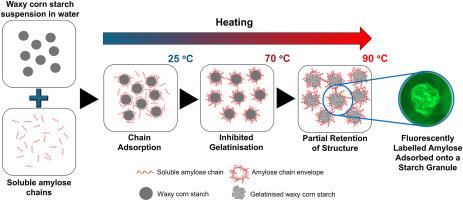Soluble amylose chains inhibit gelatinisation and retrogradation in waxy corn starch
IF 11
1区 农林科学
Q1 CHEMISTRY, APPLIED
引用次数: 0
Abstract
In this study, soluble amylose chains with varying degrees of polymerisation (DP 186–4020) were isolated via isoamylase debranching of amylopectin from native and waxy corn starches. When these soluble amylose chains are mixed with aqueous suspensions of waxy corn starch, spontaneous adsorption onto the surface of starch granules occurs. The resulting coating envelops the granules and markedly inhibits gelatinisation, increasing the onset temperature by up to 10 °C. Additionally, the amylose coating alters the pasting and short-term retrogradation properties of waxy corn starch, as evidenced by a reduction in trough viscosity, up to a 20 % decrease in breakdown viscosity, and approximately a 50 % increase in setback viscosity. This effect is both concentration- and DP-dependent. We found that chains with a critical length of 200 ≤ DP ≤ 700 produce the most pronounced effect and exhibit the strongest concentration dependence, suggesting that entropic considerations play a key role in starch−amylose interactions. Complementary analyses − including calorimetry, viscosity, turbidity measurements, and small-angle X-ray scattering − confirmed the inhibited gelatinisation and retrogradation. X-ray diffraction data further corroborated that the adsorbed amylose forms a hydrated, V-type-like polymorphic envelope. We hypothesise that this amylose coating restricts water ingress and inhibits granular gelatinisation, providing a physical basis for the observed inhibition. These findings highlight a previously undocumented role of soluble amylose chain length in directing starch thermal and structural transitions. Our results advance the fundamental understanding of starch–amylose interactions and offer a novel route for designing starch systems with enhanced functionality for applications in food processing and, more broadly, in (bio)material design.

可溶性直链淀粉抑制蜡质玉米淀粉的糊化和退化
在这项研究中,通过对天然玉米淀粉和糯玉米淀粉的支链进行异淀粉酶脱支,分离出具有不同聚合程度的可溶性直链(DP 186-4020)。当这些可溶性直链淀粉与糯玉米淀粉的水悬浮液混合时,会在淀粉颗粒表面发生自发吸附。由此产生的涂层包裹颗粒并显著抑制糊化,将起始温度提高高达10°C。此外,直链淀粉包被改变了蜡质玉米淀粉的糊化和短期退化特性,这可以通过降低谷粘度、降低高达20%的分解粘度和增加约50%的挫折粘度来证明。这种效应既依赖于浓度,也依赖于dp。我们发现临界长度为200≤DP≤700的链产生最明显的影响,并表现出最强的浓度依赖性,这表明熵因素在淀粉-直链淀粉相互作用中起关键作用。补充分析-包括量热法,粘度,浊度测量和小角度x射线散射-证实了抑制的糊化和退化。x射线衍射数据进一步证实,吸附的直链淀粉形成水合的v型多晶包膜。我们假设这种直链淀粉涂层限制水分进入并抑制颗粒糊化,为观察到的抑制作用提供了物理基础。这些发现强调了以前未记载的可溶性直链淀粉链长度在指导淀粉的热和结构转变中的作用。我们的研究结果促进了对淀粉-直链淀粉相互作用的基本理解,并为设计具有增强功能的淀粉系统提供了一条新途径,可用于食品加工,更广泛地说,可用于(生物)材料设计。
本文章由计算机程序翻译,如有差异,请以英文原文为准。
求助全文
约1分钟内获得全文
求助全文
来源期刊

Food Hydrocolloids
工程技术-食品科技
CiteScore
19.90
自引率
14.00%
发文量
871
审稿时长
37 days
期刊介绍:
Food Hydrocolloids publishes original and innovative research focused on the characterization, functional properties, and applications of hydrocolloid materials used in food products. These hydrocolloids, defined as polysaccharides and proteins of commercial importance, are added to control aspects such as texture, stability, rheology, and sensory properties. The research's primary emphasis should be on the hydrocolloids themselves, with thorough descriptions of their source, nature, and physicochemical characteristics. Manuscripts are expected to clearly outline specific aims and objectives, include a fundamental discussion of research findings at the molecular level, and address the significance of the results. Studies on hydrocolloids in complex formulations should concentrate on their overall properties and mechanisms of action, while simple formulation development studies may not be considered for publication.
The main areas of interest are:
-Chemical and physicochemical characterisation
Thermal properties including glass transitions and conformational changes-
Rheological properties including viscosity, viscoelastic properties and gelation behaviour-
The influence on organoleptic properties-
Interfacial properties including stabilisation of dispersions, emulsions and foams-
Film forming properties with application to edible films and active packaging-
Encapsulation and controlled release of active compounds-
The influence on health including their role as dietary fibre-
Manipulation of hydrocolloid structure and functionality through chemical, biochemical and physical processes-
New hydrocolloids and hydrocolloid sources of commercial potential.
The Journal also publishes Review articles that provide an overview of the latest developments in topics of specific interest to researchers in this field of activity.
 求助内容:
求助内容: 应助结果提醒方式:
应助结果提醒方式:


